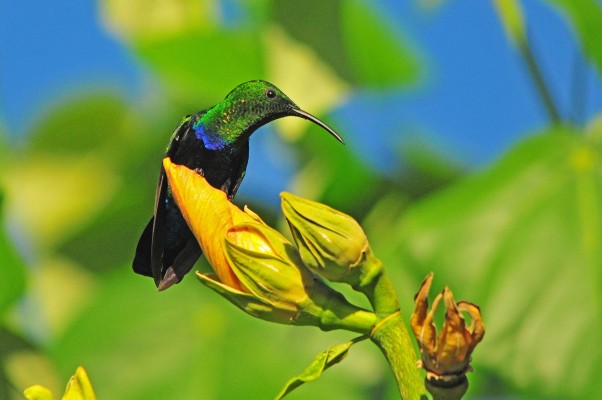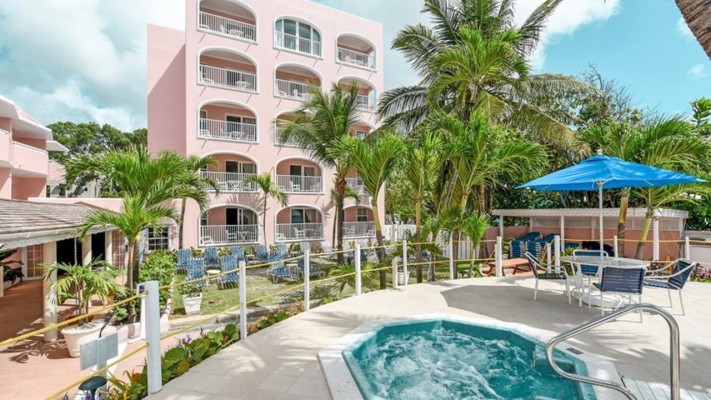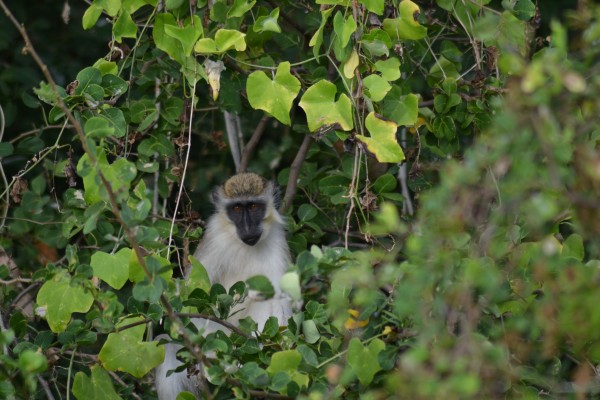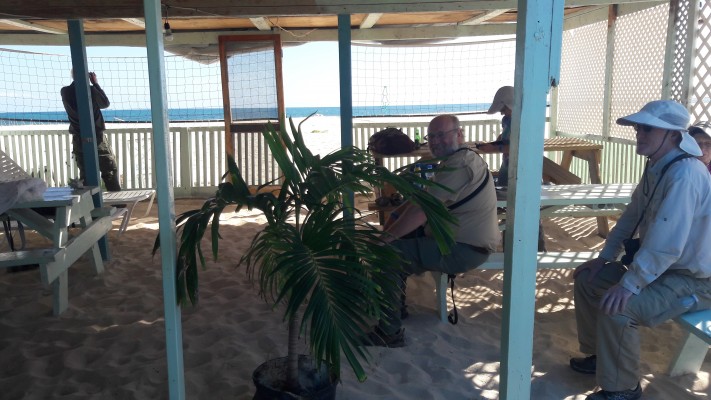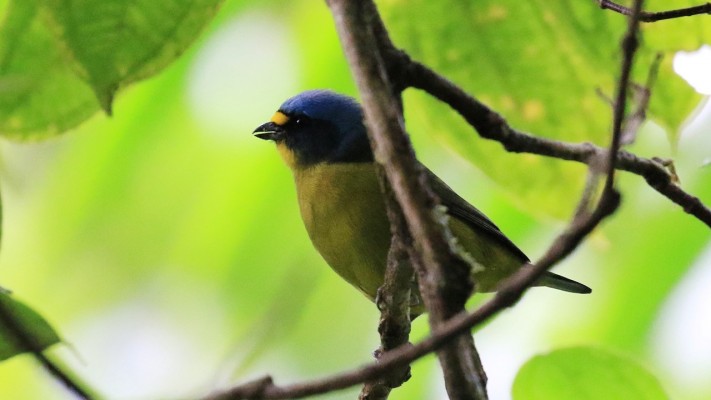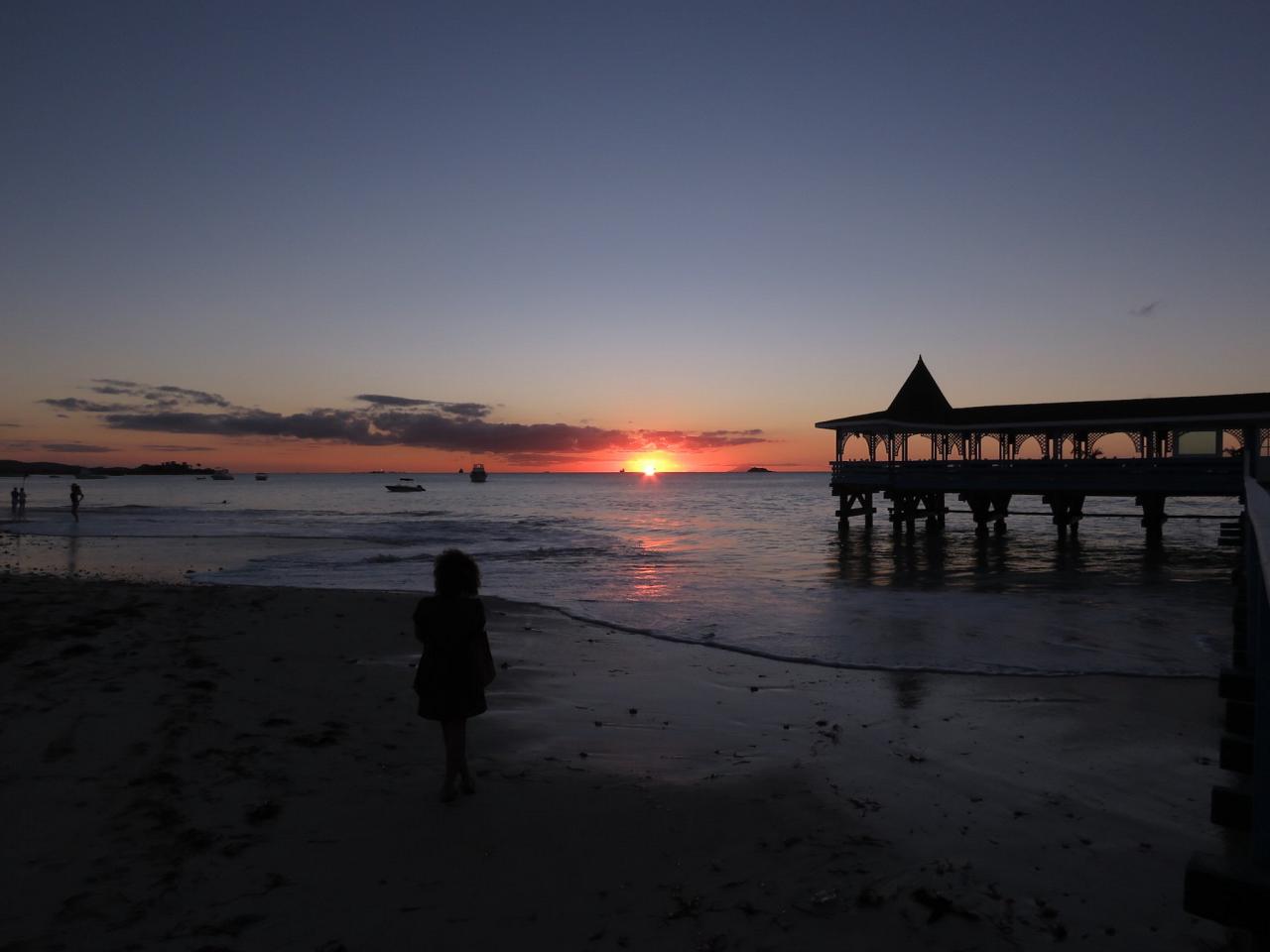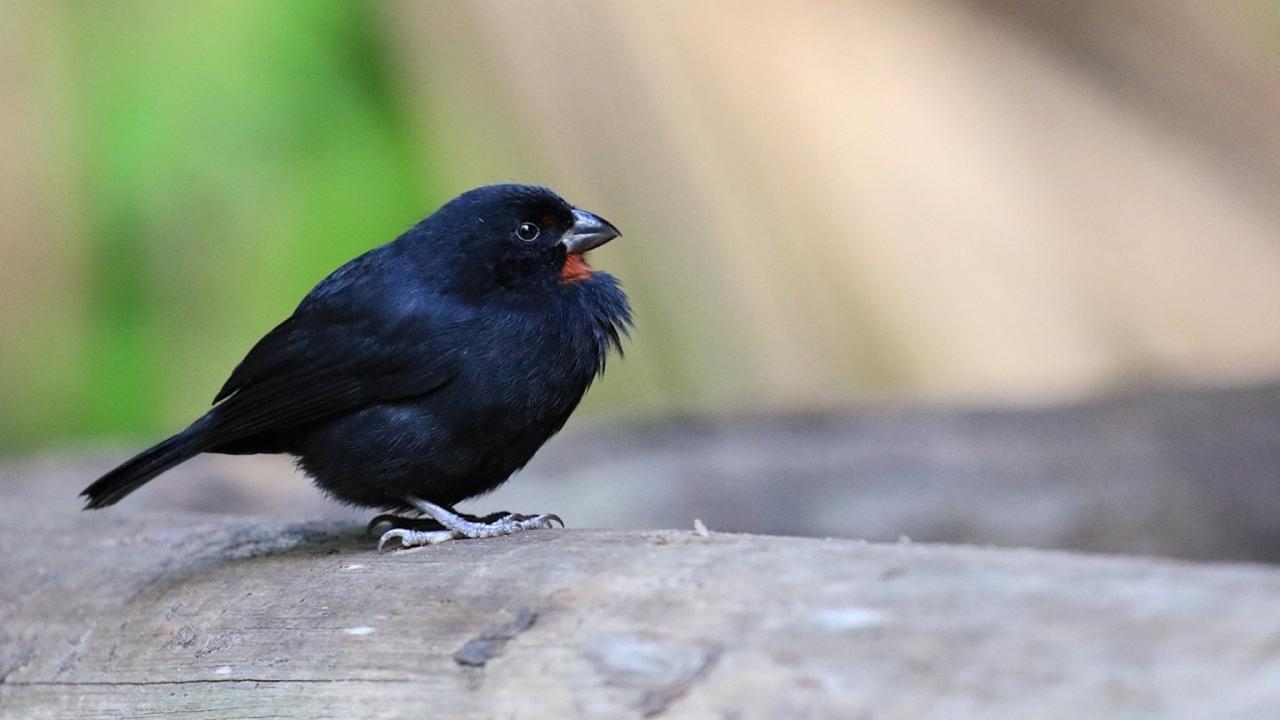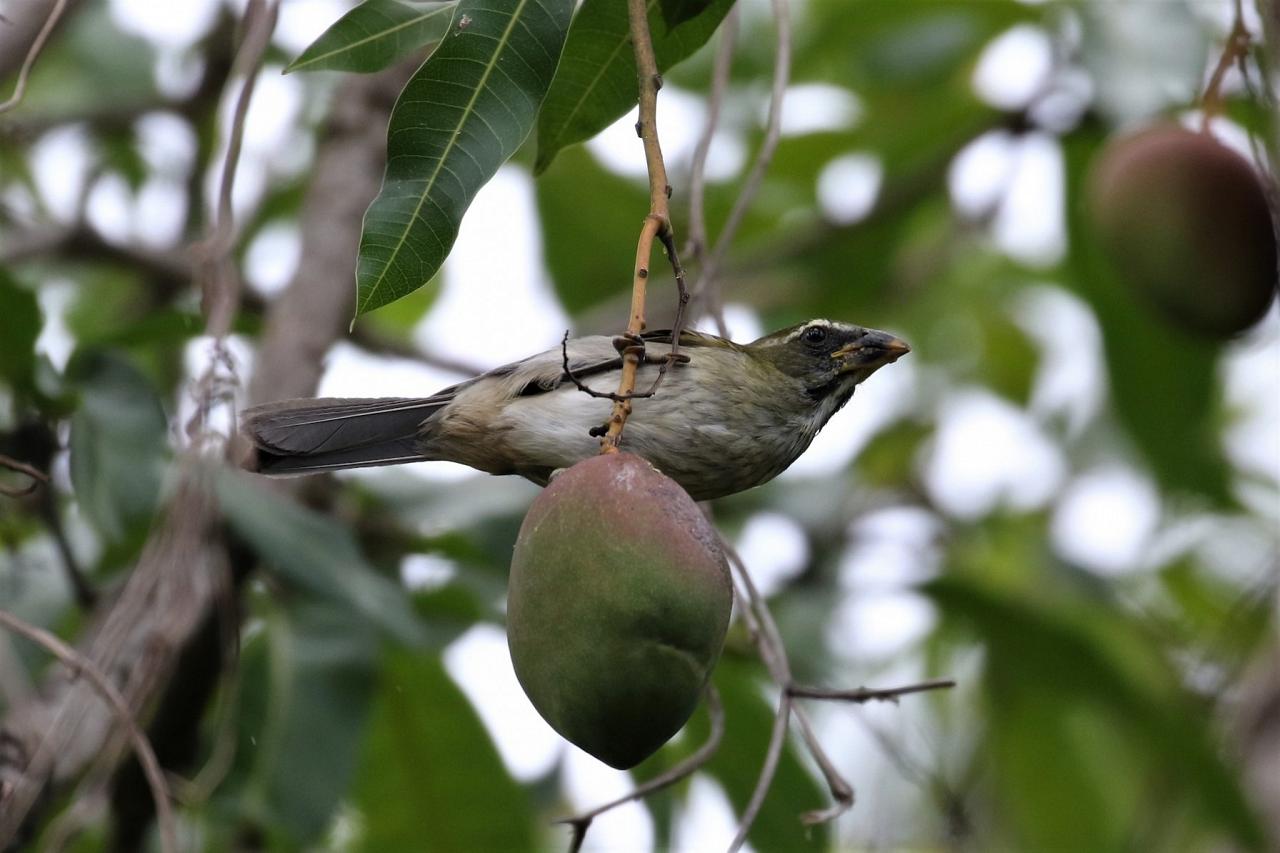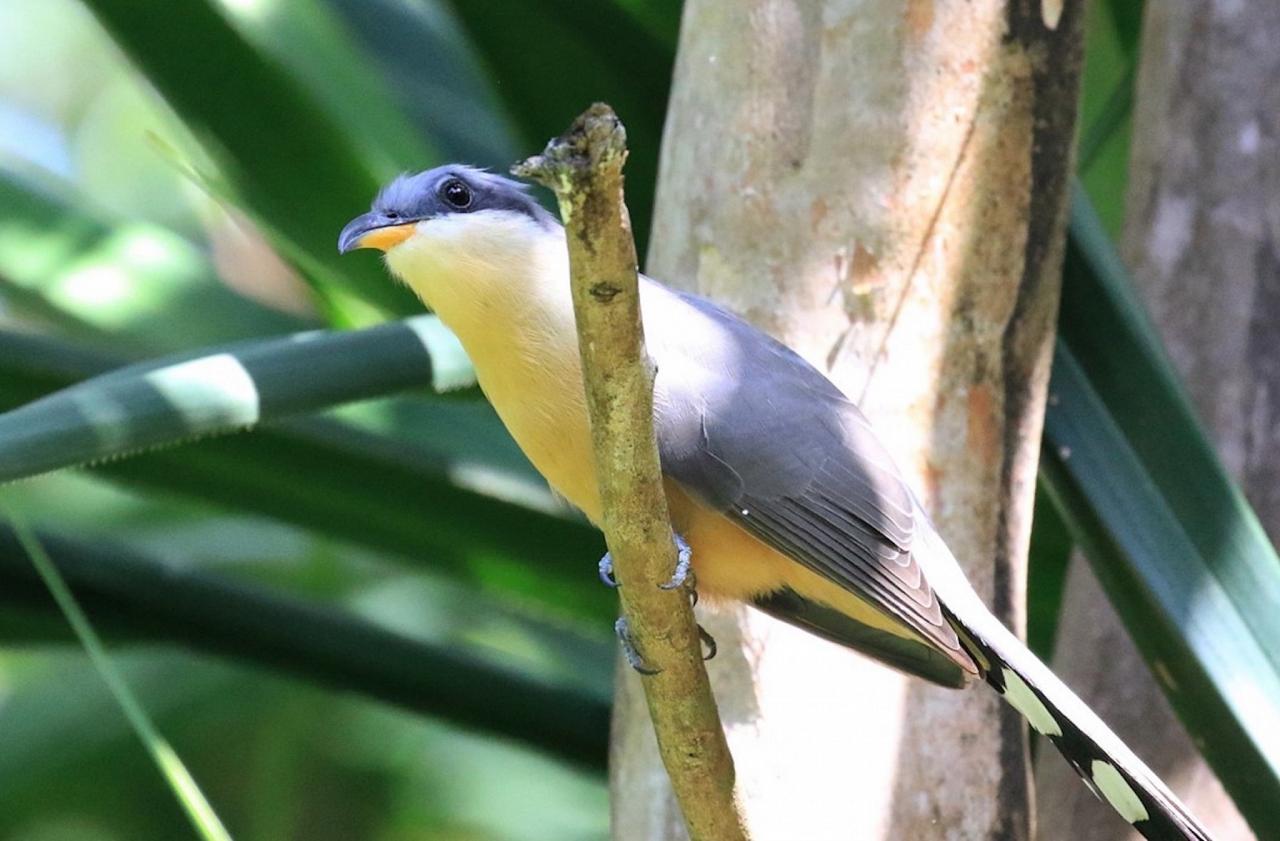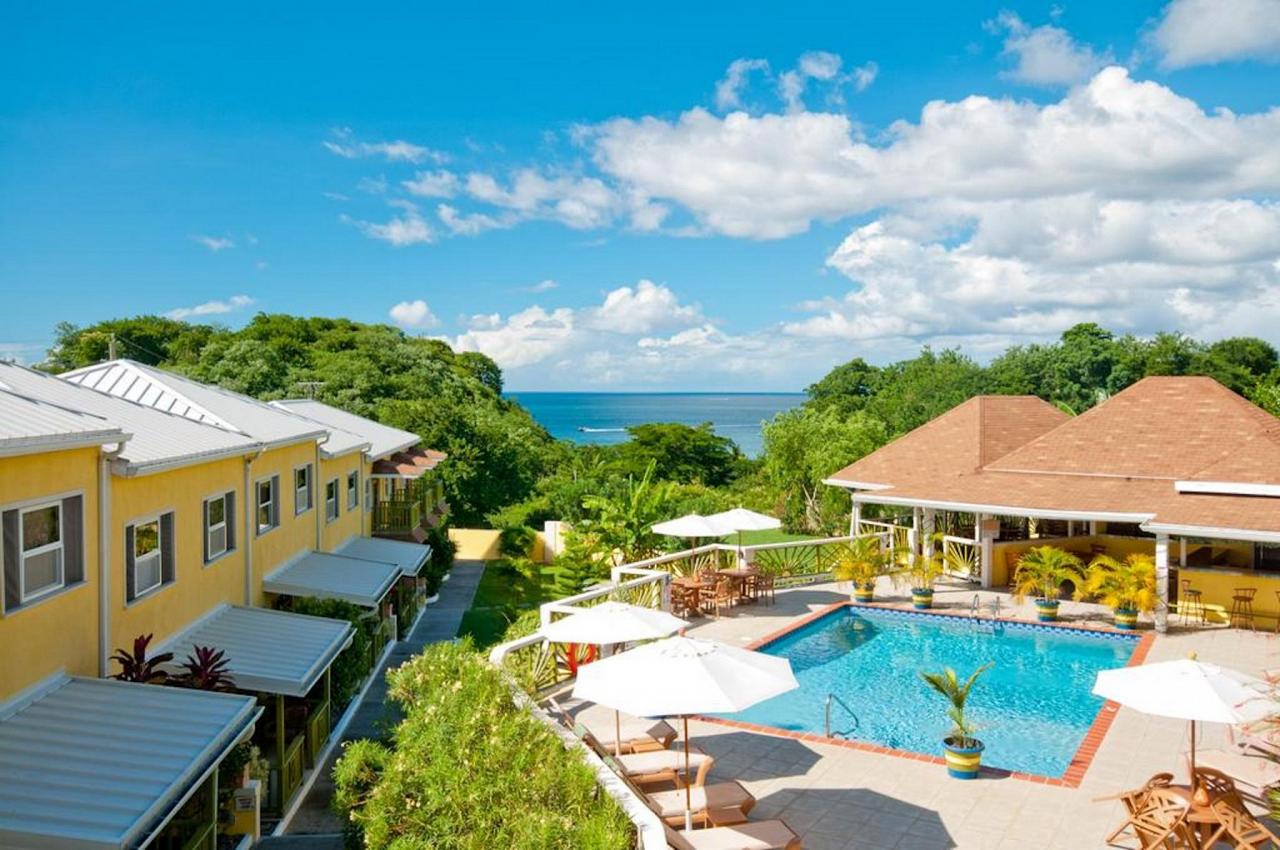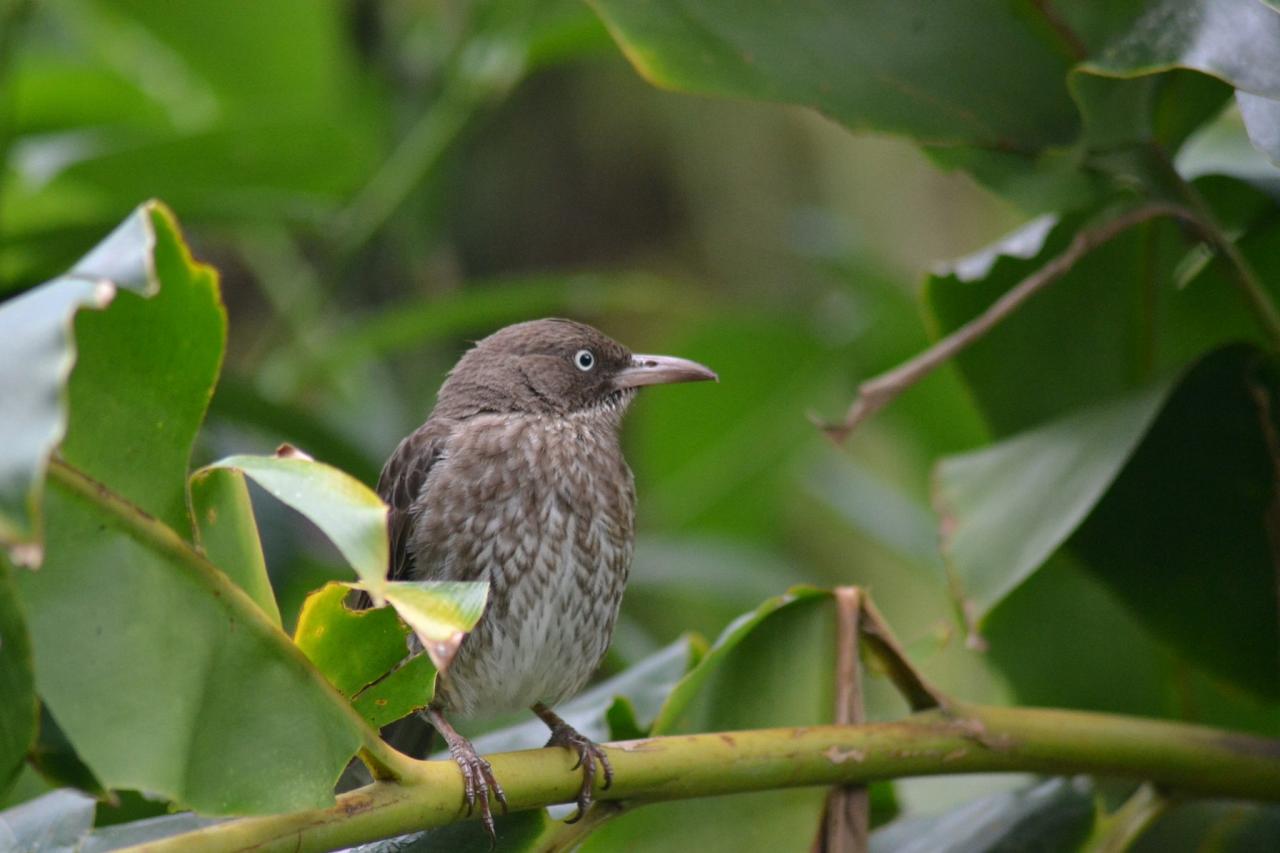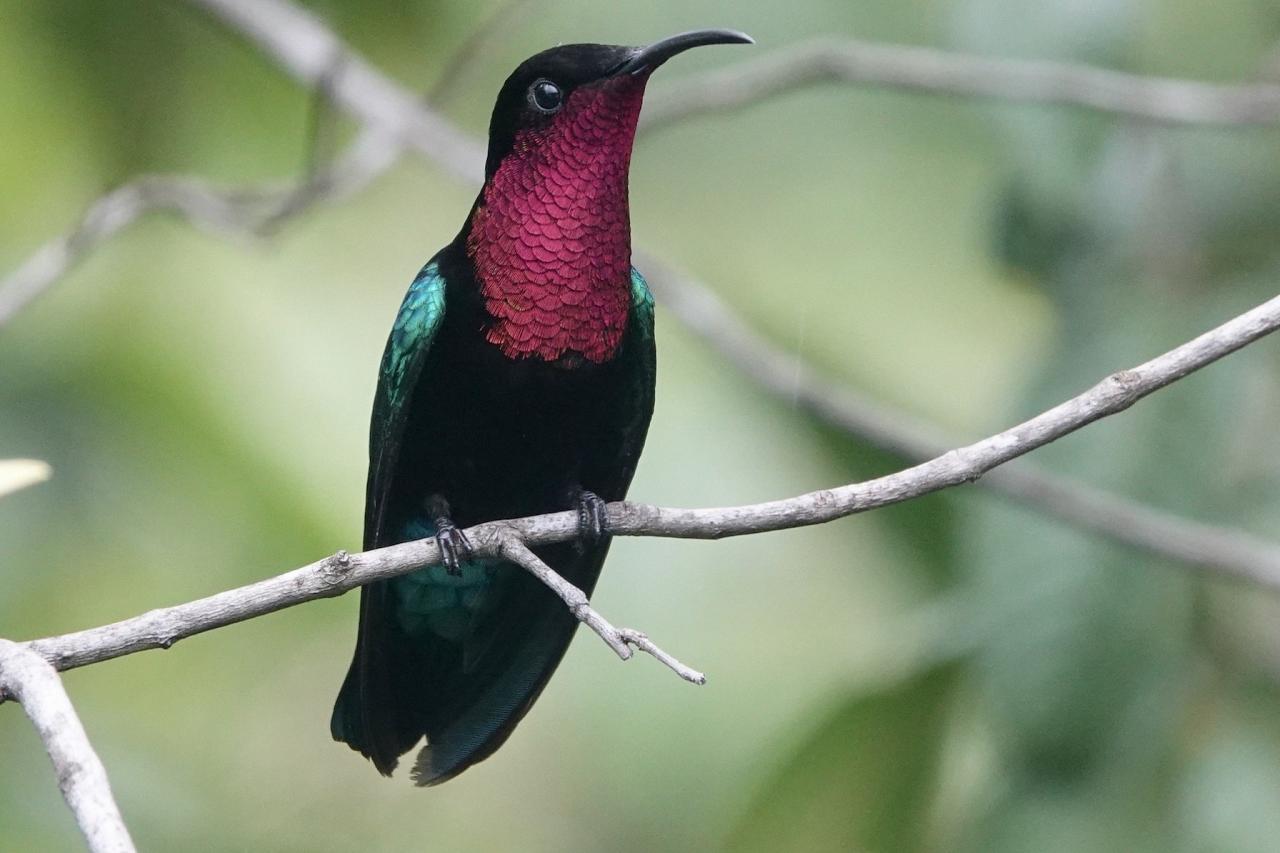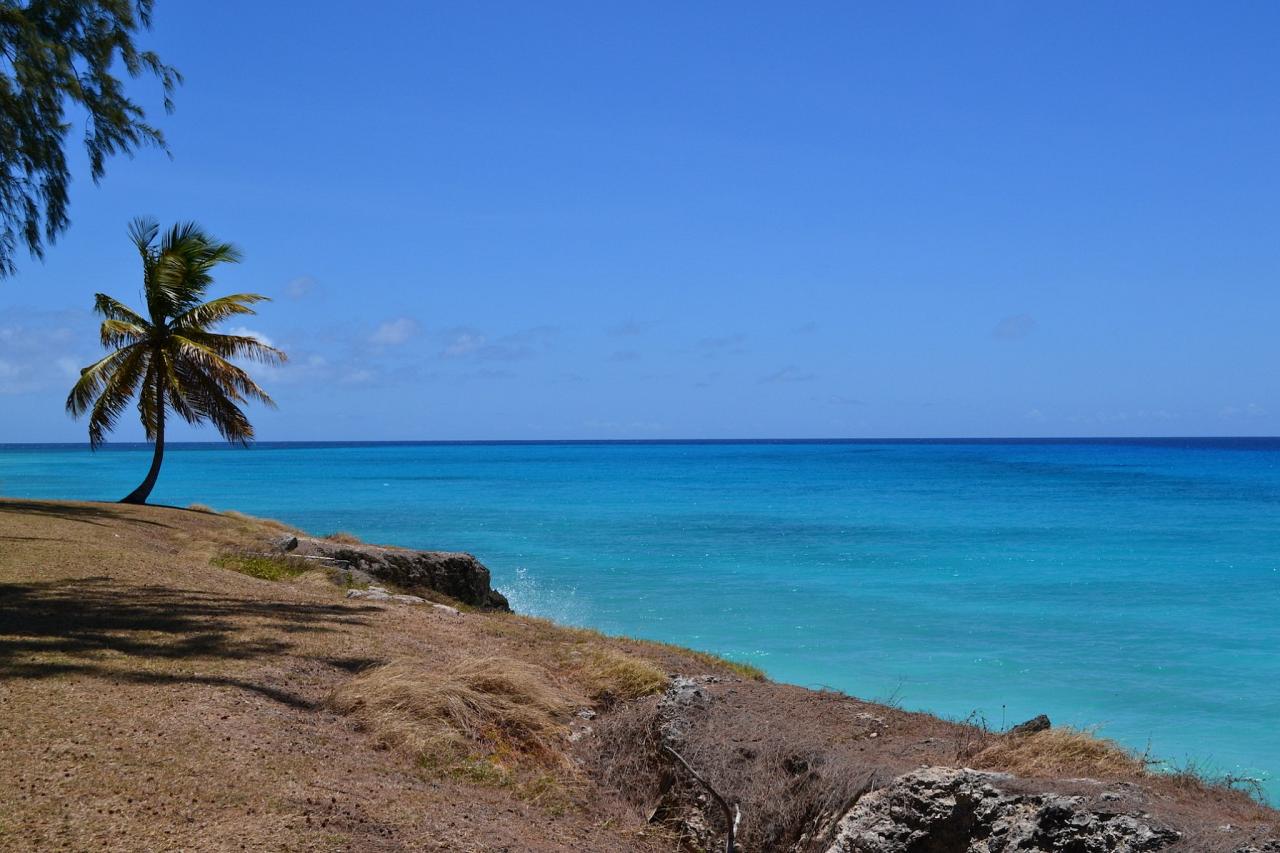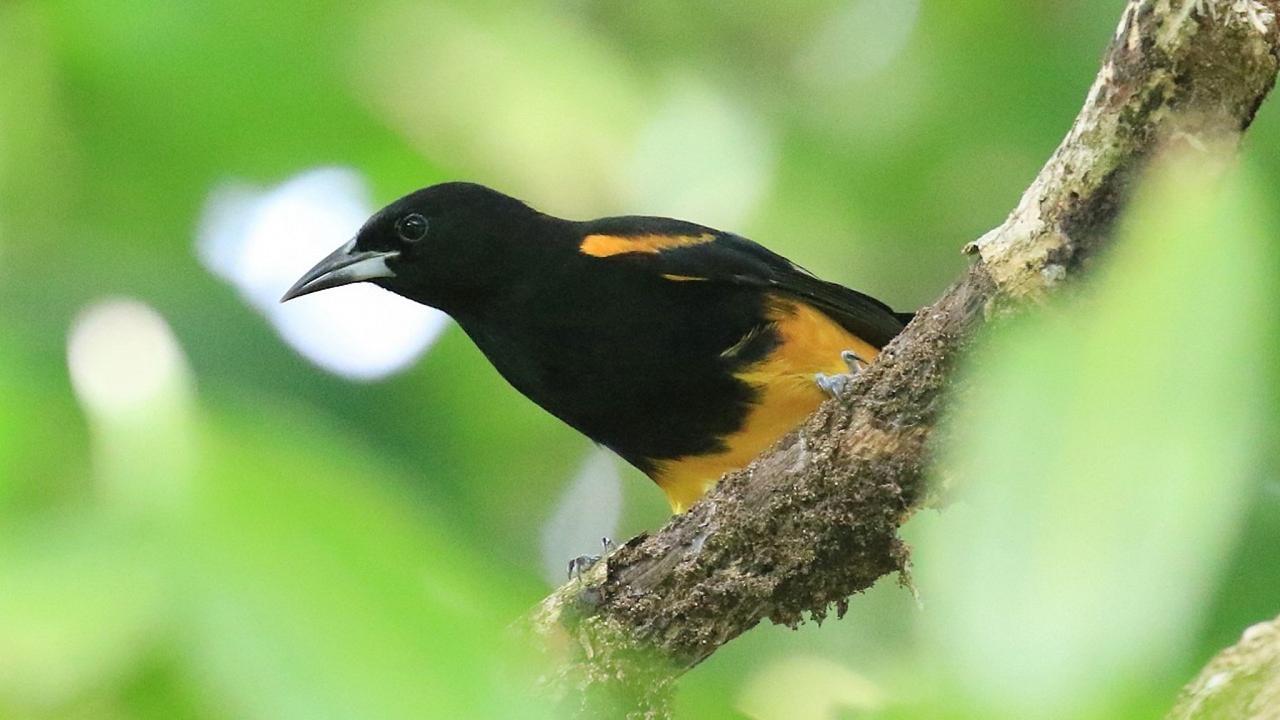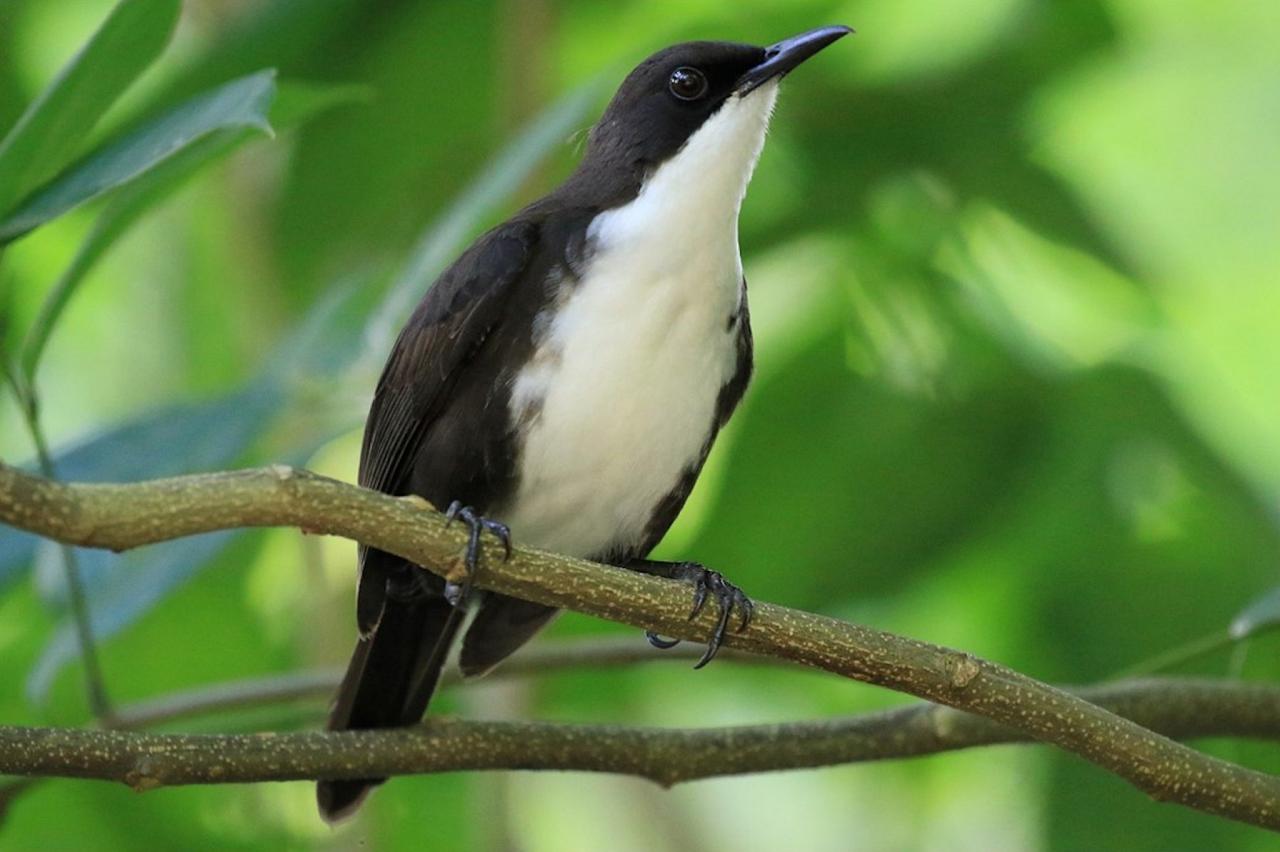Stretching from north to south between the Atlantic Ocean and Caribbean Sea, lies an arc of tropical island gems ringed by turquoise seas and sandy beaches. Uplifted by ancient volcanic forces, verdant, lush Caribbean rainforests cloak many of these sun-kissed islands, while those with limestone soils feature seasonally dry forest. Due to their relative isolation from any large landmasses, these islands host a highly threatened collection of birds found nowhere else in the world. Collectively, there are thirty Lesser Antilles endemics plus forty-five or so Caribbean specialties.
Starting in Barbados (the easternmost of the Lesser Antillean archipelago), we travel along this stunningly beautiful island chain, getting you close–very close–to spectacular wildlife, including often critically endangered single-island endemics like the Whistling Warbler in St. Vincent; the majestic Imperial Amazon in Dominica; the dazzling Purple-throated Carib and bemusing Grey Trembler on St. Lucia; the flame-breasted Montserrat Oriole on the “Other Emerald Isle”; and rarest of them all, the unassuming Grenada Dove, still found serenely walking the pathways in the only area of suitable habitat remaining on the “Spice Isle” of Grenada–all while traveling to some of the most picturesque holiday destinations on the planet. In addition to the charismatic birdlife, we also hope to experience some of the island culture and cuisine. Accommodations are locally owned and either on the coast with plenty of beach opportunities, or forested areas with pools to relax by.
Find yourself away from the exotic beach destinations on the coast on an epic birding and wildlife adventure, quite unlike any other on the planet, and sure to leave you with long lasting and wonderful memories.
By joining us on this incredible island odyssey, not only will you have the opportunity to see an array of little-known endemics and regional specialities–many of whom sadly run the gamut from threatened to critically endangered–but of also contributing directly to their conservation. Naturalist Journeys will be donating a portion of the tour price to BirdsCaribbean–a leading organization in the region dedicated to protecting the last remaining habitats of many of these species and encouraging locals to become involved in wildlife conservation. BirdsCaribben even operates a training program for local islanders to become guides–some (such as Lystra on St. Vincent and Anthony on Guadeloupe) you will have the opportunity to meet–as they will be our local guides on their respective islands!
Tour Highlights
- Enjoy the natural beauty and scenery of these tropical island paradises not often visited by other birders or naturalists
- Search for over thirty endemic bird species found only in the Lesser Antilles, including Barbuda Warbler, Grey Trembler, Purple-throated Carib, and Montserrat Oriole
- Sample the rich and flavorful fusion cuisines of the islands, with each island having a different set of traditional dishes
- Support the conservation of critically endangered species such as Grenada Dove with your visit and use of local guides
- Marvel at up to four spectacular endemic Amazona parrot species, including St. Vincent, St. Lucia, Imperial, and Red-necked
- Relax in the afternoon by snorkeling in the turquoise waters or merely strolling along ‘postcard perfect’ sandy beaches
Trip Itinerary
Itineraries are guidelines; variations in itinerary may occur to account for weather, road conditions, closures, etc. and to maximize your experience.

Sat., March 20: Arrivals in Barbados
After arriving at our beachfront accommodation, conveniently located a mere 10 minutes from the airport, we can immediately immerse ourselves into island life by enjoying a cocktail at the bar, strolling along the glistening white sands of the nearby beach, or even take a swim in the placid turquoise seas.
Our meal this evening is a selection of local Bajan dishes, enjoyed on the hotel’s open veranda with a sweeping view out across the Caribbean Sea.
Accommodations on Barbados (D)

Sun., March 21: Graeme Hall Nature Sanctuary
The Graeme Hall Nature Sanctuary, a mere ten minutes from our hotel, is a critically important 240-acre wetland that protects the last remaining mangrove forest on the island. Closed to the general public for the past ten years, we will be granted exclusive access for our group to this serene and species-rich site.
Upon entry, we assemble on the Leaf Deck and watch in awe as Atlantic Tarpon gently (and sometimes violently) break the surface of the island’s largest lake and where many of the island’s heron species occur such as Great and Little Egret, Green and Great Blue Heron, Yellow-crowned and Black-crowned Night-Heron. We meander along the well-maintained boardwalk surrounded by the verdant greens of mature red mangroves, their dense canopies the favoured perches of many of the island’s unique species. These include the nominate race of Golden Warbler, the garrulous Carib Grackle, and the endemic Barbados Bullfinch. The long dangling aerial roots of Rhizophora mangle line the walkway and provide shelter for skulking Green Heron, scurrying Barbados Anole, and armies of fiddler crabs. While in the wetland, we will also have excellent opportunities to see Grey Kingbird, as well as up-close encounters with the local subspecies of Antillean Crested Hummingbird and spectacular Green-throated Carib (two of the four hummingbirds we target on our travels through the island chain). This is also prime habitat for troops of Green Vervet Monkey (in Barbados, "Green" Monkey), a primate introduced from southern Africa centuries ago.
We follow our time at the wetland by setting off in air-conditioned comfort to a selection of local birding hotspots deep in the heart of the island – areas commonly referred to by locals as being “behind God's back.” Our drive through towering fields of sugar cane and row upon row of flowering okra and sweet potato take us deep into rural Barbados, until we are well and truly off the tourist track. Here at several quaint and secluded sites, we look for (among others) skulking Sora, flocks of Black-bellied Whistling-Duck, localized populations of Eared Dove, the ever-so-secretive Masked Duck, and wintering Wilson's Snipe.
Lunch is enjoyed at a local “rum-shop" – the name given to the many small hole-in-the-wall dives specializing in such local delights as flying fish, cuckoo, pork tail, and beef and potato rotis. These establishments are regularly frequented by Bajans as places to eat, and, as the name suggests, places at which to enjoy the odd beverage or two.
The West Indian mahogany trees that surround our hotel fill with the calls of Scaly-naped Pigeons at dusk as they select their favored roosts and the fluttering wings of Velvety Free-tailed bats as they set out to feed. Food is also on our minds, and we step out from our hotel onto the gleaming white sands of the nearby beach for a sunset stroll to the fishing village of Oistins. Here, we tuck into a delicious dinner of freshly caught grilled fish, shrimp, and lobster.
Accommodations on Barbados (B,L,D)

Mon., March 22: Grenada
Today, we take a short flight to the southernmost of the Windward Islands in the Lesser Antilles – Grenada, sometimes known as the ‘Spice Isle’ for its production of nutmeg and mace. From the air, this small and densely populated island might seem an odd destination for a birding trip. However, by visiting one of the last remaining pockets of suitable habitat on the island, we have the opportunity to observe the rarest bird we may see on the entire trip: the Critically Endangered Grenada Dove, the national bird of the island.
These doves are endemic to the thin strip of coastal dry thorn forest in Grenada. Unfortunately, this habitat is mostly gone due to both urbanization and tourism development. Mount Hartman National Park, threatened by these developmental pressures, protects the last stronghold of this species, and we will make a special effort to see this rare dove here.
After visiting the last stronghold of this delicate and unassuming dove, we explore the dry woodland that represents its natural habitat. Here, we may view several other key inhabitants of the ‘Spice Isle’, including Grenada Flycatcher, Rufous-breasted Hermit, Spectacled Thrush, and Lesser Antillean Bullfinch. We finish the day by climbing a well-positioned observation tower to scan the skies for the local race of Hook-billed Kite.
Our lodgings for the night will be a vibrantly colored and newly refurbished resort.
Accommodations on Grenada (B,L,D)

Tues., March 23: St. Vincent
The Lesser Antilles is comprised of a chain of largely submerged mountains running north to south in a double arc. The outer arc from Anguilla to Barbados features low, flat islands composed of limestone, while the inner arc features a series of volcanic cones. The heavily forested, volcanic island of St. Vincent with its mostly black sand beaches and vast sprawling wilderness sits within the inner arc.
Once we arrive at the international airport, a pre-arranged transport takes us into the lush rainforests of towering Mount Soufriere. Here along quiet forest paths lined with wild Begonia, we search for the Critically Endangered Whistling Warbler, along with a wonderful selection of near endemics and Caribbean specialties such as Lesser Antillean Tanager, Purple-throated Carib, and an all-black subspecies of Bananaquit (one of five distinct subspecies of Bananaquit found in the region!). We end our walk at a dry riverbed, above which circle Common Black as well as Broad-winged Hawk (subspecies antillarum, a near endemic known only to St. Vincent and Grenada). We may also see inquisitive sapphire-headed St. Vincent Anoles while we enjoy freshly picked fruit and plantain chips as a trail snack.
Later today, we have the privilege of potentially seeing beautiful St. Vincent Parrots flying all around us, one of four very special parrot species endemic to the Lesser Antilles. To do so, we head for a site deep in the heart of the islands' verdant forests known only to select local forestry officers, and one that sees our vehicle cross the same river SEVEN times at different locations. As our vehicle slowly ascends the mountain, we pull over at choice spots where the ever-present mangos and guavas prove an irresistible lure to Lesser Antillean Tanager, Lesser Antillean Bullfinch, Spectacled Thrush, Smooth-billed Ani and even Yellow-bellied Elaenia (drawn to the fruit flies on the ripening fruit). Eventually, we arrive at the secret location and strategically select our seats atop a scenic ridgeline in order to await the arrival of the raucous parrots returning from a day of foraging in the surrounding forests. This is a species that was long on the verge of extinction, so the opportunity to have incredibly close views of this lovely parrot in their natural habitat is one of the highlights of the trip. Furthermore, it is a testament to the monumental effort of regional and international conservationists.
Tonight, we dine in a family-owned hotel’s open-air restaurant overlooking the swaying masts of catamarans and yachts moored off Young Island. Most of the food consumed on St. Vincent is locally grown, and the wide variety on the menu is testament to the plethora of vegetables, pulses, and ground provisions (such as yam and taro) that thrive in the rich volcanic soils of the island. Try the tantalizing saltfish buljol as a starter – delicious!
Accommodations on St. Vincent (B,L,D)

Wed., March 24: St. Vincent | St. Lucia
Our day starts slowly with a relaxed breakfast on the seaside balcony before a mid-morning stroll along a spectacular white sand beach. Those feeling adventurous may even wish to don their snorkels and join the tour leader in search of the inhabitants of the reefs that line this sheltered coast – perhaps some angelfish, tangs, or wrasses. We have a leisurely lunch at a beachside restaurant from which we may see Brown Pelican, Royal Tern, and Brown Booby, before making the short ten-minute drive to the airport.
Following a 20-minute early-afternoon flight, we touch down in spectacular St. Lucia.
Upon arrival at the regional airport in Castries (the vibrant capital of St. Lucia), we explore a large open-air market selling almost everything that the diverse and varied islands of the Caribbean have to offer. We taste fresh fruit, sample local culinary delights, and browse through artisanal crafts.
From Castries, we drive through the rural heart of the country to the tranquil east coast where we stop at the quaint seaside village of Dennery. Here, we can experience the intense bartering culture practiced by generations of local fishermen and their customers, who line the pier in anticipation of returning boats. Afterwards, we arrive at our accommodations for the next few nights. Here, among the manicured gardens and tropical flowers, Tropical Mockingbird and Grey Kingbird flit from one swaying palm to another, their diverse calls seeming to beckon us down towards the pool for a swim before dinner.
The Inn is owned and managed by a lovely couple. Esther is a Swiss expat who handles the business side of things, while Frank, who is St. Lucian, prepares the fine cuisine. He trained and worked in Paris as a chef for many years. Prepare your taste buds for a treat! All the ingredients for our meals at Foxgrove are locally sourced, directly supporting this local community. We enjoy our meals here on an outdoor balcony with sweeping views of Praslin Bay.
Accommodations at the Foxgrove in St Lucia (B,L,D)

Thurs., March 25: St. Lucia
The following morning, we enjoy a leisurely breakfast before making the short drive to see one of the last populations of the rare White-breasted Thrasher, a species listed as Endangered by the IUCN. These thrashers inhabit seasonally dry Caribbean forest where they prefer areas of abundant leaf litter. Other inhabitants of this forest type include Lesser Antillean Saltator, Mangrove Cuckoo, and St. Lucia Black Finch.
Following our time here, we drive to a tiny local hillside village where we learn from local Rastafarians of the many uses and local remedies of native flora. Afterwards, we continue to a wetter forest type known to harbor many of the island's indigenous and endemic species. It is no exaggeration to state that numerous target species of birds here will join a myriad of butterflies. Overhead, Lesser Antillean Swift effortlessly manoeuvre in the island breeze; St. Lucia Warbler peer underneath the leaves of tropical trees to gorge on caterpillars; Lesser Antillean Flycatcher and Lesser Antillean Pewee sally for insects from tree snags; and St. Lucia Oriole probe ripening fruit.
Before we head back to our hotel, we travel to a reliable location to potentially see one of the most difficult specialties on the island, Rufous Nightjar.
Accommodations at the Foxgrove in St Lucia (B,L,D)
Fri., March 26: St. Lucia
Today, we awake to a packed breakfast and pre-arranged transport take us to the island’s showpiece natural attraction – the lush Des Cartiers Rainforest. Des Cartiers is dominated by numerous trees endemic to the region, along with tree ferns, bromeliads, and orchids. We spend a wonderful morning here, walking the well-maintained trails and getting to know the diverse species of flora all around us, including the endemic and aromatic Lansan.
Our forest walk culminates at an observation area where we may see the island’s national bird, the magnificent St. Lucia Parrot. A myriad of other forest birds dwell at this site. The ethereal song of the Rufous-throated Solitaire and the high-pitched note of the Lesser Antillean Euphonia intermingle with the other sounds of the forest, while Grey Trembler and Caribbean Elaenia may also make an appearance.
Leaving this verdant forest behind, we make for the scenic west coast where we eat lunch at what is surely the restaurant with the best view on the island, grand views of the twin spires of the Pitons – ancient volcanic plugs and a World Heritage Site. After lunch, we wind our way down into historic Soufriere and enter a gargantuan caldera for a memorable tour of the only drive-thru volcano in the western hemisphere!
We finish the day atop one of the island’s highest peaks, where we are treated to the spectacular aerial acrobatics of a colony of Red-billed Tropicbird.
Accommodations at the Foxgrove in St Lucia (B,L,D)

Sat., March 27: Dominica
Today, we take a short flight to Dominica, nicknamed the Nature Isle of the Caribbean. With its innumerable waterfalls and rivers coursing through its vast tracts of primary rainforest, Dominica offers a snapshot into what some of the more developed islands of the region would have resembled years ago.
Upon arrival on the island, we stop at a popular roadside stand to sample a selection of homemade and refreshing tamarind and golden apple juices, before driving up into the Northern Forest Reserve. We may soon hear the musical calls of an array of Lesser Antillean species, causing us to stop and investigate.
Upon doing so, we are immediately met with a variety of birds: Brown Trembler, Blue-headed Hummingbird, Plumbeous Warbler, Red-legged Thrush, Forest Thrush, Black-whiskered Vireo, Scaly-breasted Thrasher, and more. As our van climbs ever-higher along the track, we scan the roadside for Red-rumped Agouti, Dominican Ameiva, and Lesser Antillean Iguana.
Later today, we venture into the Carib territories. These eight villages represent the last remaining stronghold of a people who once lived throughout the Lesser Antilles. This visit gives us an insight into the lives of the original inhabitants of the Lesser Antilles, allowing us to learn about their culture and enjoy a traditional Carib meal before making the short drive to our coastal accommodation.
Accommodations in Dominica (B,L,D)
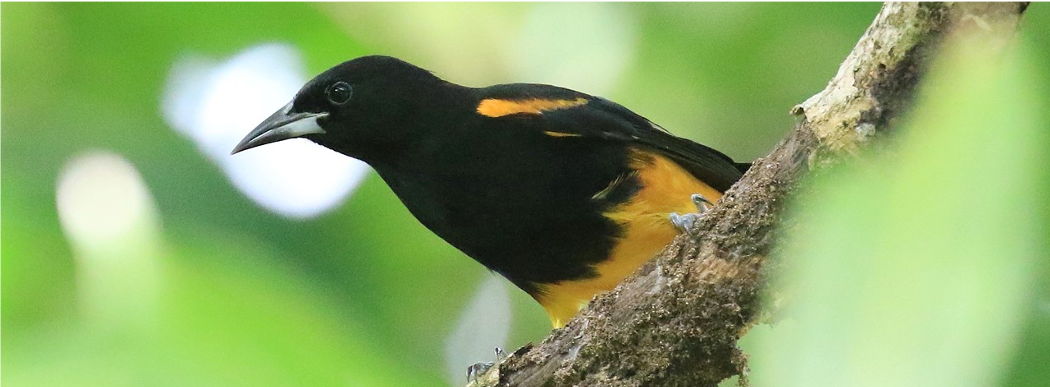
Sun., March 28: Dominica
This morning, we wake up to the smell of rich Dominican coffee as we set off before dawn in order to give ourselves the best opportunity of seeing one of the Caribbean’s rarest and most spectacular parrot species – the majestic Imperial Parrot. We scan from a vantage point overlooking deep verdant valleys, carefully scrutinizing the towering tree canopy for this parrot as well as its more numerous cousin, the Red-necked Parrot. Flowering plants nearby offer feeding opportunities for the near-endemic Blue-headed Hummingbird. Fifty-five species of butterfly occur in this forest, including regional endemics such as Dominican Hairstreak and St. Lucia Mestra.
Dominica’s waters are home to several species of whale and dolphin. In fact, Dominica is known as the whale watching capital of the Caribbean! After our morning enjoying the wildlife in the high montane forest, we join an experienced captain and crew out into the deep blue waters for a chance to see Sperm Whale, Spinner Dolphin, Pantropical Spotted Dolphin, and more. Dominica is the only country in the world whose waters are home to both mothers and calves of Sperm Whale all year round! While on our quest for marine mammals, we take advantage of our time out on the water to see pelagic bird species such as Cory’s Shearwater and Wilson’s Storm-Petrel.
Accommodations on Dominica (B,L,D)
Mon., March 29: Guadeloupe
We continue onwards today to Guadeloupe, the first of two French Overseas Territories that we visit on our journey. Guadeloupe is a remarkable island, for its forests not only provide glimpses of some of the more secretive species rarely seen on other islands (normally shy Bridled Quail Dove may be walking at our feet here!) but where one can also get very close views to a most curious endemic. The feeding habits of the Guadeloupe Woodpecker, the only woodpecker endemic to the Lesser Antilles, is quite unusual. Birds often dangle upside down while clinging to slender swinging branches and plucking ants from clusters of berries! Odd? Yes. But it certainly allows for fabulous looks!
The lush forests of Guadeloupe also represent a wintering and stopover site for a variety of migratory North American warblers, and we are likely to encounter American Redstart, Northern Waterthrush, Black-and-white Warbler, Northern Parula, and others during our birding here.
Our cottages, surrounded by swaying palms and flowering bougainvillea, offer the perfect post-birding relaxation spot, and we dine this evening on a wonderful blend of French cuisine with Caribbean Creole influence.
Accommodations in Guadeloupe (B,L,D)
Tues., March 30: Martinique
With our packed breakfast on board with us, we head for the stunning and heavily forested island of Martinique, another French Overseas Territory. By this stage in our travels, any prior belief that a visit to one island in the Lesser Antilles is akin to visiting another will have vanished. The differences in topography and geology, along with the varied ethnicities, histories and cultural differences of populations, ensure that a visit to the islands of the Lesser Antilles is very much an exploration of ten very individual and unique countries.
In the capital city of Martinique, Fort-de-France, games of boules play out on well-manicured pitches and small cafes line the courtyards in a way unlike anything we have seen on previous islands. It is testimony to a very strong French influence. The island also boasts a striking single-island endemic, the Martinique Oriole. While in truly spectacular primary forest, we will also be looking for Black-whiskered Vireo and Blue-headed Hummingbirds (in case this delightful near-endemic hummer proved elusive in Dominica), as well as targeting the island's striking subspecies of rufous-hooded Yellow Warbler and Ruddy Quail Dove.
Accommodations in Martinique (B,L,D)
Wed., March 31: Antigua
At midday, we make the flight to sun-kissed Antigua – the island with a beach for every day of the year. Upon arrival in the early afternoon, our pre-arranged transport collects us and drives us to our quiet country inn nestled to the east of the capital of St. John’s. After check-in, we enjoy a stroll on the hotel grounds, which boasts an array of tropical flora that attracts Lesser Antillean Flycatcher and White-crowned Pigeon. By keeping an eye in the skies overhead we may see the endemic subspecies (and smallest in the region) of Broad-winged Hawk.
Our accommodation is renowned for its rich repertoire of Caribbean cuisine, so dinner is sure to be a treat!
Accommodations in Antigua (B,L,D)

Thurs., April 1 : Barbuda
Today, we make the ten-minute drive to Antigua’s main port, where we embark on a day trip to the smaller sister of this twin island state, Barbuda. We soon find ourselves heading by boat across some of the most beautiful waters in the Caribbean Sea.
Once we arrive in Barbuda, one immediately sees the stark contrast between the heavily developed tourist destination of Antigua and this little visited island, where vast stretches of undisturbed beaches, sheltered coves, and dry coastal forests support a different cast of characters to those previously encountered on our trip. Our main target here is the diminutive Barbuda Warbler, the island’s only endemic bird species. This charming warbler is perfectly at home in the dry scrub and shares this habitat with species such as Common Ground Dove, Zenaida Dove, White-winged Dove, Black-faced Grassquit, Lesser Antillean Iguana, and (bizarrely) herds of feral donkey!
Barbuda is also home to the largest Magnificent Frigatebird colony in the entire Caribbean. These avian pirates are most commonly seen soaring high above the waves, carefully scanning the waters for food floating on the surface or stealing the catch of other seabirds. So, it is a wonderful treat to board a dinghy that takes us across a shallow lagoon absolutely teeming with marine life (as evidenced by the hundreds of jellyfish of every shape and size clearly visible beneath us) and moors us literally within touching distance of nests, chicks, and adults. We spend half an hour in the presence of these incredible birds, observing their behavior and watching as squadrons of adults swoop in and return with food to their nest.
One is struck by the spectacular and unspoiled natural beauty of Barbuda while driving around the island. It is ‘postcard’ perfect. The water is a glistening turquoise blue, and the colors of the sands effortlessly blend between brilliant whites and varying shades of pink. With some of the most untouched beaches in the Caribbean on either side of us, what better way to spend the rest of the day than a ‘Robinson Crusoe-esque’ beach bar to enjoy a delicious meal of mahi mahi, chicken, or lobster. We then follow it up with an optional swim or snorkel in shallow waters and a stroll along an idyllic white sand beach known to be frequented by Royal, Sandwich, and Least Tern. This truly is a case of birding in paradise!
On our return leg across the sun-kissed seas to Antigua, we have the opportunity for yet more dolphin and whale encounters.
Accommodations in Antigua (B,L,D)

Fri., April 2: Montserrat
Widely known as the ‘Emerald Isle of the Caribbean’, one can circumnavigate Montserrat by foot and never leave the lush expanse of dense primary forest that dominates this magical island. The volcanic eruption of 1995 rendered half of the island uninhabitable, covering it in a pyroclastic flow and causing a significant proportion of the population to emigrate to the United Kingdom. What remains is quite simply stunning. The volcano itself still smolders, but it is constantly monitored by volcanologists who have declared the northern half of the island safe for residents and visitors alike.
Thankfully, this is also the half of the island where we may find our target bird species, the endemic Montserrat Oriole. This striking oriole is our number one target, and we walk the quiet paths of this ancient forest until we come to a stand of giant heliconias. Here is our best site for seeing the orioles. As we have ensured that we are on the island during nesting season, it is highly likely that such stands will reveal both the olive-green female and fiery-breasted male!
Montserrat is also the best island for seeking a species of thrasher that can prove difficult on other islands. Pearly-eyed Thrasher is abundant on Montserrat and can be approached relatively closely both within and on the outskirts of the forest. Another target and one which will require far more patience is the secretive Forest Thrush (a Lesser Antillean endemic – and here on Montserrat, the subspecies dorotheae is endemic).
As we continue our walk through this picturesque habitat, the forest floor can be just as alive as the trees above. Leaves rustle everywhere. Montserrat’s anoles scuttle across the ground, the non-venomous Montserrat Racer warms itself in patches of sunlight, and unbelievably tiny geckos no bigger than the tip of your thumb study us from beneath the fallen leaves on the path before us.
Back at our lunch spot, we sit back, relax, and celebrate the day’s birding with a hearty meal and the opportunity to wash it down with a local specialty – Bush Rum! No sugarcane used in this one – only select local herbs and plants gathered from the forest!
That evening, after yet another delicious dinner, we go over the varied trip list while enjoying views of the Caribbean Sea one last time on our journey. What better way to reflect on our travels and wind down our time in the magical islands of the Lesser Antilles.
Accommodations in Monserrat (B,L,D)
Sat., April 3: Antigua
We begin our final day with a leisurely buffet breakfast enjoyed on our hotel’s verandah. A short drive from our accommodation is one of Antigua's prime expanses of mangrove wetland, and we take full advantage of our last day in the islands with a morning’s birding session looking for overwintering shorebirds, resident herons, and American Coot. There may even be small numbers of the highly threatened West Indian Whistling-Duck!
After lunch, we can enjoy the sun beside our hotel’s large pool and soak up the last of the tropical rays before the trip back home. Please schedule outgoing flights in the afternoon. (B)
Cost of the Journey
Cost of the Journey is $7590 DBL / $8380 SGL, based on double occupancy, per person.
The tour price includes airport transfers, all flights between islands and internal ferry and boat charges, 14-night accommodations, all meals as stated in the itinerary, park admission fees, hotel and restaurant service charges, and guide fees.
Cost of the journey does not include airfare from your home to Barbados, or items of a personal nature, such as drinks from the bar, telephone, and local guide gratuities (at your discretion, we will give some guidelines).
Travel Details
Please plan to make air travel plans only after the minimum group size has been met. We will send you a confirmation email as soon as the trip has been confirmed.
Please plan to arrive at 1 PM at Grantley Adams International on March 20. Please plan departures from V.C Bird International Airport in Antigua after noon, on April 3. However, if it is easier or more convenient to fly back home from Barbados, an extra charge will be added for the flight from Antigua to Barbados.
-
Ryan Chenery - Caribbean Expert

Ryan Chenery was born and raised in beautiful Barbados! Ryan’s first job on the island took him beneath the waves where he conducted coral reef surveys for the Bellairs Research Institute. Yet it wasn't long before his passion for birds and wildlife on terra firma saw him employed as Chief Naturalist and Eco-Guide Manager at the largest remaining mangrove wetland on Barbados (the Graeme Hall Nature Reserve), and later travelling further afield to conduct field research on birds and amphibians in the Brazilian Atlantic Rainforest and Ecuadorian Amazon.
After being swept off his feet by a Yorkshire Lass, he followed her to England where he continued his passion for “all things birds" with employment at the Royal Society for the Protection of Birds. Here he spent three years at the organization’s internationally renowned seabird reserve Bempton Cliffs, where highlights included kittiwake monitoring in gale-force winds and rescuing disoriented gannets by perching both he and the birds precariously on the edge of 300 ft cliffs - to better allow them to catch enough updraft to head back out to the North Sea! Subsequent employment in the UK saw Ryan take on the role of National Parks Officer at the North York Moors National Park – a position he held for 3 years before returning to Barbados to conduct multi-island wildlife trips full time. Ryan has enjoyed all of the wonderful roles he has undertaken across the globe, but his greatest passion remains leading wildlife adventures through the magical islands of the Lesser Antilles. The tiny island gems will always be his home and he loves nothing better than sharing the unique wildlife, vibrant cultures and untamed wildernesses that each island has to offer with nature enthusiasts from around the world. Oh, and the food, he absolutely loves the island food, and has even been known to also share this...occasionally!Photo credit: The Bajan Birder
Other trips with Ryan Chenery - Caribbean Expert
-
 Lesser Antilles Endemics: A 10-Island Birding SpectacularJanuary 28 - February 10, 2027
Lesser Antilles Endemics: A 10-Island Birding SpectacularJanuary 28 - February 10, 2027
-
Pace & Protocols +
Photo credits: Antillean Crested Hummingbird, Keith Clarkson; Humpback Whales, Ryan Chenery; Green Turtle, Ryan Chenery; Fishing off of Montserrat, Ryan Chenery; Green-throated Carib, Sam Barone; Birding Group, Ryan Chenery; Accommodation in Barbados, Keith Clarkson; Barbados Green Monkey, Ryan Chenery; Beachside Dining, Ryan Chenery; Brown Booby, Yves-Jacques Rey Millet; Lesser Antillean Euphonia, Keith Clarkson; Imperial Parrot, Terry Anderson; Crossing the lagoon, Ryan Chenery; Golden Warbler, Beatrice Henricot; Grenada Flycatcher, Beatrice Henricot; Scaly-breasted Thrasher, Keith Clarkson; St. Vincent Amazon, Keith Clarkson; Blue-headed Hummingbird, Beatrice Henricot; Martinique Warbler, Beatrice Henricot; Plumbeous Warbler, Beatrice Henricot; Montserrat Oriole, Beatrice Henricot; West Indian Whistling-Duck, Yves-Jacques Rey Millet; Red-necked Amazon, Steve Kornfield; St. Lucia Oriole, Keith Clarkson; Sunset in Antigua, Ryan Chenery; View from balconies in St. Lucia. Ryan Chenery; Accommodations in St. Lucia, Esther Ferdinand; Sunset in Antigua, Ryan Chenery; Lesser Antillean Bullfinch, Keith Clarkson; Lesser Antillean Saltator, Beatrice Henricot; Mangrove Cuckoo, Keith Clarkson; Accommodation in Grenada, courtesy of the resort; Pearly-eyed Thrasher, Ryan Chenery; Purple-throated Carib, Mark Greenfield; Soufriere St. Lucia, Ryan Chenery; South Point Barbados, Ryan Chenery; St. Lucia Oriole, Keith Clarkson; White-breasted Thrasher, Keith Clarkson.








